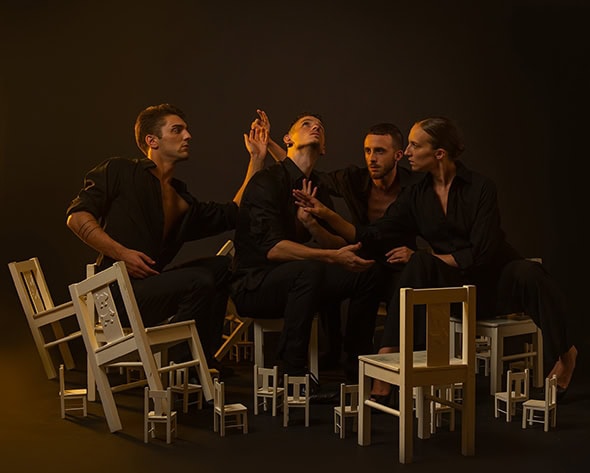Cas Public and Kopergietery in 9 at the Linbury Theatre
Posted: June 10th, 2019 | Author: Nicholas Minns & Caterina Albano | Filed under: Performance | Tags: Alexander Ellison, Cai Glover, Cas Public, Danny Morissette, Daphnée Laurendeau, Émilie Boyer-Beaulieu, Hélène Blackburn, Johan de Smet, Kenneth Michiel, Kopergietery, Marq Frerichs, Martin Tétrault, Michael Slack, Robert Guy, Slim Dakhlaou | Comments Off on Cas Public and Kopergietery in 9 at the Linbury TheatreCas Public, 9 at the Linbury Theatre, Royal Opera House, May 30

With its recent refurbishment, the Linbury is now a theatre ideally suited for dance. The stage may be only slightly deeper than before but the visibility from the more sharply raked seating is what it should be, unobstructed; even when there’s action on the front of the stage it’s not obscured. This is the kind of theatrical environment needed for Cas Public’s new work, 9, because there is so much detail to take in at any one moment that only a full and uninterrupted view of the stage allows us to benefit from its full effect. 9 is a coproduction between Cas Public — its name derives from the company’s commitment to dealing with social issues and its conviction of the artist’s role in society — and Kopergietery, a performing arts space in Ghent. What links the two companies is their shared focus on creating works for young audiences; Kopergietery’s artistic director, Johan de Smet, is the dramaturg for 9.
It’s not immediately obvious this is a performance for young audiences; such works tend to default to a language that underestimates youthful sophistication, but Cas Public’s founder and artistic director, Hélène Blackburn, rejects this approach. As she explains to Gerard Davis in a program interview: ‘I don’t think there’s that much difference between adults and children — the adult is a child who has grown up, while the child is an adult in the making. I don’t see why I can’t address my work to a multigenerational audience — lots of art forms like circus, music and the visual arts do it, so why not dance?’
Blackburn goes a step further in 9 by involving children in the performance. While the audience is entering the auditorium the five dancers (Alexander Ellison, Cai Glover, Robert Guy, Daphnée Laurendeau and Danny Morissette) engage the attention of children and invite them on to the stage (presumably there is a successful negotiation with the parents because everyone seems happy with the arrangement). The stage is covered in dozens of white liliputian chairs with a couple of tables around and through which stage technician Slim Dakhlaou guides a white, radio-controlled VW beetle. The dancers challenge the children in musical chairs and table chess until what looks like a preparatory intervention leads into the show itself when Glover takes off his hearing device — he has a cochlear implant — and puts it on a spotlit chair. The children remain on stage, implicated directly in the performance by the dancers or seated on the side.
Blackburn’s line of research for 9 starts with Glover’s hearing loss and his innate ability to dance — Blackburn thinks he dances better without his hearing aid — and continues through Beethoven’s deafness to an exploration of his Ninth symphony. The meaning of the work derives from a range of visual and auditory caesura that symbolise both the difficulty of hearing loss and the creative achievement in overcoming it. Martin Tétrault’s splicing of Beethoven’s Für Elise and his Ninth symphony brilliantly conveys the idea of music arriving in Beethoven’s head in halting, perfectly formed bars of sound that are sometimes distorted by low frequencies, and yet all the music’s power and joy are maintained. Emilie Boyer-Beaulieu’s quickly changing pools of light emphasize the fitful attempts at expression that Blackburn unites in her quicksilver gestural vocabulary derived from both classical ballet technique and sign language. Michael Slack’s stylishly casual black costumes keep all the attention on the action and, when shirts get loose, on the physical tension of the torso. The performance maintains a subversive sense of humour throughout — dancers on all fours barking at each other (and at the children) or Guy and Laurendeau snatching an embrace in the midst of a demanding unison sequence — that only enhances the tactile intricacy of the work. Kenneth Michiels’ film sequences of a young Belgian boy with hearing loss experimenting with his cochlear implant and his voice are full of humour and empathy in equal measure.
All these elements are seamlessly linked together with such clarity of form that they inspire through their cumulative emotional charge; it’s choreography that imagines what it’s like to hear again and the exhilaration in the audience is palpable.
The company’s secret ingredient is Marq Frerichs, assistant to Blackburn and in charge of the dancers’ training. ‘I’m a Cecchetti guy,’ he says smiling, and it’s evident in the clean, fast footwork, and the impressive ballon that all the dancers manifest.
Cas Public will be performing 9 this August at Edinburgh International Festival.